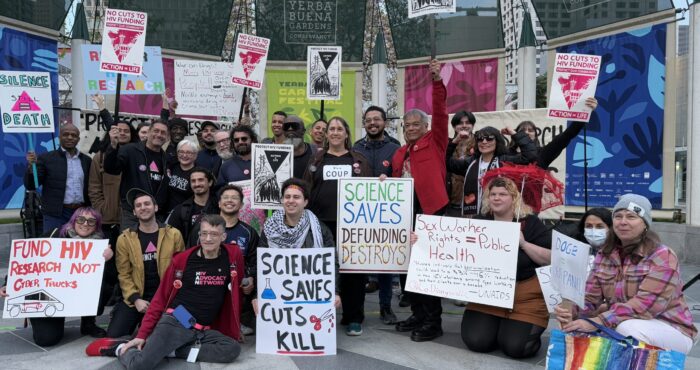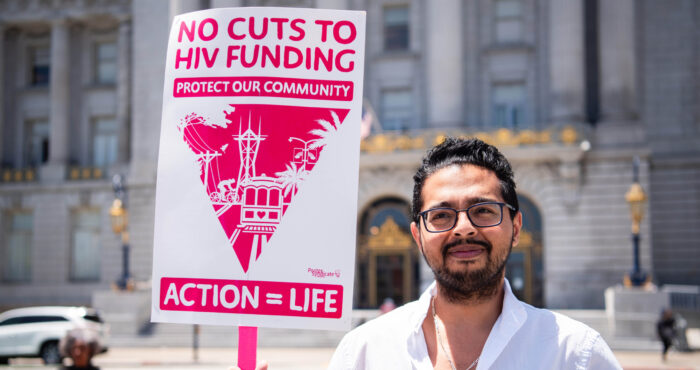Why are HIV meds so expensive, and what can we do about it?
Last month, Turing Pharmaceuticals CEO Martin Shkreli sparked outrage in the HIV community—and beyond—by hiking the price of a generic drug used to treat an opportunistic infection by more than 5,500 percent to $750 a pill. Daraprim was approved by the FDA more than 60 years ago to treat toxoplasmosis, a common parasitic infection that can cause severe symptoms in people with HIV or otherwise suppressed immune systems, but was only acquired by Turing in August. Although the price increase was legal, the outcry was loud and Turning’s CEO agreed to lower the price. The debate has escalated to Democratic presidential candidate Hillary Clinton, who has asked the FDA to investigate.
While the Daraprim example does not fully represent the story of why so many HIV and hepatitis C drugs carry such high price tags, the case brings up complicated, and controversial, questions of how drugs are priced. Why do Americans and their insurers pay more for some drugs and less for others? And who decides what a fair price for a drug should be, and how can manufacturers and health plans be compelled to improve access and affordability?
To unwrap some of these issues, BETA asked two experts for input: Courtney Mulhern-Pearson, director of state and local affairs for San Francisco AIDS Foundation, and David Evans, a member of the HIV and hepatitis C drug advocacy group Fair Pricing Coalition.
BETA: I’d like to hear your thoughts about the purchase and price hike of Daraprim. Is it common practice for companies to hike the cost of a drug so dramatically?
Courtney: Although this has happened before, I wouldn’t say it’s common practice for a company to acquire then dramatically raise the price of a generic drug. But, it does help spur this conversation about the cost of HIV and hepatitis C medications. HIV medications have been costly for a long time, but the costs now are getting so astronomical that the issue is really getting more attention. It’s just not the full story.
David: I agree. While this isn’t the first time a company bought a generic drug, became the exclusive provider of it, and jacked up its price by tens or hundreds of percent, this instance really struck a chord. I think it was because the CEO was so brazenly unapologetic and not at all deferential. He claimed [the profit] would be shuffled back into research and development, but that’s something every company says they’re doing with their profit. It’s unverifiable so we can’t trust that this is the case.
How do pharmaceutical companies set the price for a new medication? Are there any limits on the price they can ask—and get—for it?
Courtney: We don’t have any national price control in the U.S. That means that there’s no cap on drug prices. We’re a market driven system—so what brings drug prices down is competition. For example, take the two newer hepatitis C drugs Harvoni and Sovaldi. They were priced extremely high for a few reasons. First, they were marketed as a cure, so Gilead Sciences [the manufacturer of Harvoni and Sovaldi] was able to claim that the treatment would be ‘one and done.’ These aren’t maintenance drugs that people will have to take for the rest of their lives so Gilead only profits from an individual person for a short amount of time. Also, there wasn’t any competition from other manufacturers—Gilead was the only company producing and selling a medication cure for hepatitis C. So Gilead was able to set high prices knowing that people would pay it.
Research and development costs for a new drug are not insignificant. Drug companies want to recoup the money they’ve already spent in addition to make a profit. How does the Fair Pricing Coalition (FPC) decide what a fair price for a drug should be?
David: On one end of the spectrum, you have people who think that HIV and hepatitis C drugs should produce little to no profit—that drugs should cost under $100 a year because that is how much it costs a generic manufacturer in India to make them. And then you have people on the other side of the spectrum—in the business community—who think that pharmaceutical companies should be able to charge whatever they want. The FPC wants innovation to continue, and so realizes that this has to be a factor in drug pricing. But costs are hidden by industry, making it very difficult to say what is fair. We do our best to estimate the costs of the research, evaluate the price of competitors, if any, and the value of the drug to people living with the disease.
Invariably, the price we arrive at as fair is almost always quite a bit lower than what it ends up costing. That said, we are often successful at gaining other types of concessions so that the people who need the drugs have access and aren’t gouged at the pharmacy or in their premiums.
We tell [pharmaceutical] companies that they absolutely cannot bankrupt government programs like ADAP [AIDS Drug Assistance Program] and Medicaid. This is something the new hepatitis C drugs have threatened to do to Medicaid and the VA [Veterans Affairs] system. We also say that they should not set prices so high that insurers pass along costs to consumers in the form of high copays, or in the form of restricted access.
Who actually pays the price of the drug that’s set by the manufacturer?
Courtney: Health plans negotiate the price that they’ll pay the pharmaceutical companies for each drug—so that’s really where the rub is. Plans that have more buying power—in other words, have more clients who are going to take and pay for the drug that’s being negotiated—are able to negotiate lower prices with the pharmaceutical companies.
But sometimes health plans aren’t able to negotiate a lower price. When that happens, and the drug price is really high, health plans may put that drug on a specialty tier. This means that the consumer will [have] a higher copay to access the drug. Instead of a $10 per month copay, the consumer might have to pay $50 a month to get the drug. Neither consumers, nor pharmaceutical companies, like it when drugs are put on a specialty tier because it limits access. Keep in mind that health plans are trying to make a profit too—so that’s one reason they will pass on costs to the consumer.
Federal and state assistance programs like ADAP, Medicare, Medicaid (also known as Medi-Cal in California) also negotiate with pharmaceutical companies. And ADAP actually operates a fairly substantial rebate program.
What will help bring drug prices down?
David: One of the things the FPC does is call for transparency. We want to know how much money was put into research and development. How much it actually costs to make and distribute the drug; what kinds of discounts are actually given to payers.
Lawmakers in Congress could make policy changes that allow the government to step in and regulate drug prices. For instance, by setting reasonable prices for drugs based on their value and other factors. I believe we are one of the only countries in the world where this doesn’t happen, and recently lawmakers and candidates running for President—Hillary Clinton was the most recent—have released policy points to address this.
We also call on payers to be transparent about their own costs and processes for how they manage access to drugs and the drug copayments that they charge their customers. It’s a two-way street, and so often it is the person living with the disease who gets caught in the middle.
What advice do you have for consumers that need to access specialty drugs or medications with high copays?
Courtney: It’s a good time to be thinking about this as we’re leading up to open enrollment and people are considering their health insurance coverage through their employer or Covered California. I think our common refrain is to make sure you know what drugs you’re on and how the plan you’re on or interested in is tiering those drugs. If you’re taking four medications a month that all have a $50 copay, that’s $200 a month you’ll need to budget for. Look at all of your plan options. It might be worth it to pay for a plan with better drug coverage if you’ll pay less in copays every month.
If you’re HIV-positive, take advantage of programs like ADAP. And if you qualify for patient assistance programs from pharmaceutical companies, take advantage of those, too.
David: I hope that people will be engaged in the political process and not think of it as a waste of their vote, time or interest. Yes, we have a very dysfunctional government, and it’s very hard to get anything done. But our votes do matter. Because they don’t just shape public policy, they shape what we talk about as a country. And one of the things we know about from polls is that drug pricing is a major concern for all people—Democrat or Republican. Getting involved in the political process and holding our candidates responsible for dealing with drug costs is really important.










